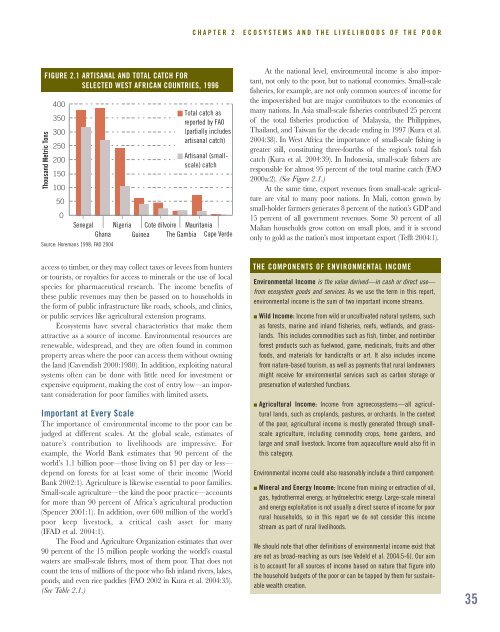jp8589 WRI.qxd - World Resources Institute
jp8589 WRI.qxd - World Resources Institute
jp8589 WRI.qxd - World Resources Institute
Create successful ePaper yourself
Turn your PDF publications into a flip-book with our unique Google optimized e-Paper software.
CHAPTER 2<br />
ECOSYSTEMS AND THE LIVELIHOODS OF THE POOR<br />
Thousand Metric Tons<br />
FIGURE 2.1 ARTISANAL AND TOTAL CATCH FOR<br />
SELECTED WEST AFRICAN COUNTRIES, 1996<br />
400<br />
350<br />
300<br />
250<br />
200<br />
150<br />
100<br />
50<br />
0<br />
Total catch as<br />
reported by FAO<br />
(partially includes<br />
artisanal catch)<br />
Artisanal (smallscale)<br />
catch<br />
Senegal Nigeria Cote díIvoire Mauritania<br />
Ghana Guinea The Gambia Cape Verde<br />
Source: Horemans 1998; FAO 2004<br />
At the national level, environmental income is also important,<br />
not only to the poor, but to national economies. Small-scale<br />
fisheries, for example, are not only common sources of income for<br />
the impoverished but are major contributors to the economies of<br />
many nations. In Asia small-scale fisheries contributed 25 percent<br />
of the total fisheries production of Malaysia, the Philippines,<br />
Thailand, and Taiwan for the decade ending in 1997 (Kura et al.<br />
2004:38). In West Africa the importance of small-scale fishing is<br />
greater still, constituting three-fourths of the region’s total fish<br />
catch (Kura et al. 2004:39). In Indonesia, small-scale fishers are<br />
responsible for almost 95 percent of the total marine catch (FAO<br />
2000a:2). (See Figure 2.1.)<br />
At the same time, export revenues from small-scale agriculture<br />
are vital to many poor nations. In Mali, cotton grown by<br />
small-holder farmers generates 8 percent of the nation’s GDP and<br />
15 percent of all government revenues. Some 30 percent of all<br />
Malian households grow cotton on small plots, and it is second<br />
only to gold as the nation’s most important export (Tefft 2004:1).<br />
access to timber, or they may collect taxes or levees from hunters<br />
or tourists, or royalties for access to minerals or the use of local<br />
species for pharmaceutical research. The income benefits of<br />
these public revenues may then be passed on to households in<br />
the form of public infrastructure like roads, schools, and clinics,<br />
or public services like agricultural extension programs.<br />
Ecosystems have several characteristics that make them<br />
attractive as a source of income. Environmental resources are<br />
renewable, widespread, and they are often found in common<br />
property areas where the poor can access them without owning<br />
the land (Cavendish 2000:1980). In addition, exploiting natural<br />
systems often can be done with little need for investment or<br />
expensive equipment, making the cost of entry low—an important<br />
consideration for poor families with limited assets.<br />
Important at Every Scale<br />
The importance of environmental income to the poor can be<br />
judged at different scales. At the global scale, estimates of<br />
nature’s contribution to livelihoods are impressive. For<br />
example, the <strong>World</strong> Bank estimates that 90 percent of the<br />
world’s 1.1 billion poor—those living on $1 per day or less—<br />
depend on forests for at least some of their income (<strong>World</strong><br />
Bank 2002:1). Agriculture is likewise essential to poor families.<br />
Small-scale agriculture—the kind the poor practice—accounts<br />
for more than 90 percent of Africa’s agricultural production<br />
(Spencer 2001:1). In addition, over 600 million of the world’s<br />
poor keep livestock, a critical cash asset for many<br />
(IFAD et al. 2004:1).<br />
The Food and Agriculture Organization estimates that over<br />
90 percent of the 15 million people working the world’s coastal<br />
waters are small-scale fishers, most of them poor. That does not<br />
count the tens of millions of the poor who fish inland rivers, lakes,<br />
ponds, and even rice paddies (FAO 2002 in Kura et al. 2004:35).<br />
(See Table 2.1.)<br />
THE COMPONENTS OF ENVIRONMENTAL INCOME<br />
Environmental Income is the value derived—in cash or direct use—<br />
from ecosystem goods and services. As we use the term in this report,<br />
environmental income is the sum of two important income streams.<br />
■ Wild Income: Income from wild or uncultivated natural systems, such<br />
as forests, marine and inland fisheries, reefs, wetlands, and grasslands.<br />
This includes commodities such as fish, timber, and nontimber<br />
forest products such as fuelwood, game, medicinals, fruits and other<br />
foods, and materials for handicrafts or art. It also includes income<br />
from nature-based tourism, as well as payments that rural landowners<br />
might receive for environmental services such as carbon storage or<br />
preservation of watershed functions.<br />
■ Agricultural Income: Income from agroecosystems—all agricultural<br />
lands, such as croplands, pastures, or orchards. In the context<br />
of the poor, agricultural income is mostly generated through smallscale<br />
agriculture, including commodity crops, home gardens, and<br />
large and small livestock. Income from aquaculture would also fit in<br />
this category.<br />
Environmental income could also reasonably include a third component:<br />
■ Mineral and Energy Income: Income from mining or extraction of oil,<br />
gas, hydrothermal energy, or hydroelectric energy. Large-scale mineral<br />
and energy exploitation is not usually a direct source of income for poor<br />
rural households, so in this report we do not consider this income<br />
stream as part of rural livelihoods.<br />
We should note that other definitions of environmental income exist that<br />
are not as broad-reaching as ours (see Vedeld et al. 2004:5-6). Our aim<br />
is to account for all sources of income based on nature that figure into<br />
the household budgets of the poor or can be tapped by them for sustainable<br />
wealth creation.<br />
35

















